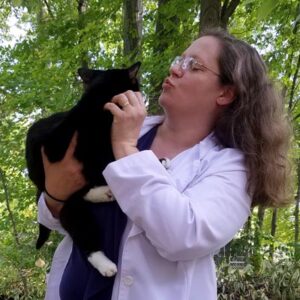Unlike many veterinarians who feel called to their profession from an early age, Kelli Barton had already reached young adulthood before deciding to pursue a career in veterinary medicine. But once she set her mind to becoming a veterinarian, her determination was unwavering, despite some obstacles along the way.
It all started with Mrs. Elsey.
“I’ve always felt a connection with animals, but I had few opportunities to interact with them when I was growing up. It wasn’t until I got to Mrs. Elsey’s ninth grade biology class that I really had the opportunity to be around them.

“In seventh grade, I remember telling a classmate, ‘I’ll never be a scientist because science is boring.’ We had fake microscopes, and all they had covered in science classes up to that point were rocks and dinosaurs. But in Mrs. Elsey’s class, I totally fell in love with biology. It was all about how living things fit and worked together. A whole world opened up and, from that point on, I was hooked.”
Besides being an exceptional teacher, Judith Elsey was a lifelong animal lover and a strong supporter of the Terre Haute Humane Society. Through a student volunteer group Mrs. Elsey organized for her students, Dr. Barton got her first experience working with animals at the humane society. Their mentor/student relationship continued throughout high school and Dr. Barton’s early college years.
“Initially, I was interested in marine biology or freshwater ecology but had no interest in medicine,” recalled Dr. Barton. “I remember, as a high school senior, standing in the science room and telling Mrs. Elsey, ‘I’ll never be a doctor,’ because I had no interest in human medicine. I hadn’t yet been exposed to the opportunity to practice veterinary medicine.”
After finishing high school, while completing her undergraduate degree, Dr. Barton worked at the local shelter full-time and a local pet food supply store part-time. When the shelter started an in-house spay/neuter program for the adopted animals, the first spark of a career in veterinary medicine was lit.
“We were a small rural shelter with minimal resources. The spay/neuter program opened the door. I could see not only the need, but the tools to fill that need and change things for the better.”
Over the next few years, Dr. Barton finished her undergraduate degree, got married, and moved to Indianapolis, where she worked for two years as a surgical and medical assistant at the Humane Society of Indianapolis. “With the medical team onsite, I got a lot of good feedback and experience there,” she said.
Despite extensive hands-on experience in the field, Dr. Barton’s first attempts at being admitted to veterinary school were unsuccessful.
“The application process for vet school is extremely competitive, and at that point I had to switch gears a bit. Working two jobs and attending undergrad full-time took its toll, and some of my grades were not as competitive as I would have liked. So, on the advice of a friend, I retook a few of the courses, got better grades, and then enrolled in a pre-professional master’s program at Indiana University–Purdue University Indianapolis. Afterward, I worked on a research project in the cardiology department at the Wells Center for Pediatric Research. I learned great deal about cardiac anatomy and function that carried forward to not only vet school, but also my role as a veterinarian.”
This time, when she applied to veterinary programs, Dr. Barton was admitted to Ontario Veterinary College at the University of Guelph in Canada—ranked among the five to seven best veterinary schools in the world.
“It took me awhile to gravitate toward veterinary medicine, but once I decided, that was it,” she said. “It wasn’t a matter of if. It was a matter of when. People kept saying ‘no’ to me along the way, but I believed in myself and I knew I was capable.”
After receiving her veterinary degree in 2012, Dr. Barton returned to work at the Humane Society of Indianapolis at their off-site Animal Welfare Center. In 2014, she left shelter medicine to practice in small animal clinics, spending more than five years in her most recent position. She joined Brownsburg Animal Clinic as an associate veterinarian in October 2020.
Dr. Barton and her husband Ryan, a software engineer, share their home with three cats—Lieutenant, a 17 and a half-year-old shelter cat who is missing a kidney, Copernicus, a stray “love sponge” brought into the Indianapolis shelter blind, with chronic rhinitis, conjunctivitis, a ruptured eardrum and a flea infestation, and Sticks, a feral cat paralyzed in the rear and surrendered by a good samaritan to the clinic where she previously worked.
“Lieutenant is the most normal of the three,” said Dr. Barton. “Copernicus is blind, and Sticks has a kind of bunny-hop run he taught himself. They don’t know anything’s wrong with them.”
In her free time, in addition to caring for the cats, Dr. Barton enjoys gardening, with a special interest in cultivating native perennial plants, and baking breads, pastas and pastries. Since 2004, she has been a martial arts practitioner of Tang Soo Do. “I am currently at a Master Dan level belt rank,” she said. “It is very much a part of who I am, and I can’t imagine not doing it.”

